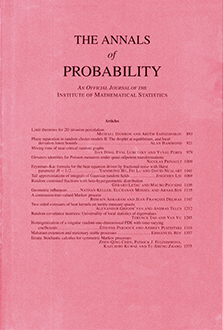Abstract
We consider a system of particles which perform branching Brownian motion with negative drift and are killed upon reaching zero, in the near-critical regime where the total population stays roughly constant with approximately $N$ particles. We show that the characteristic time scale for the evolution of this population is of order $(\log N)^{3}$, in the sense that when time is measured in these units, the scaled number of particles converges to a variant of Neveu’s continuous-state branching process. Furthermore, the genealogy of the particles is then governed by a coalescent process known as the Bolthausen–Sznitman coalescent. This validates the nonrigorous predictions by Brunet, Derrida, Muller and Munier for a closely related model.
Citation
Julien Berestycki. Nathanaël Berestycki. Jason Schweinsberg. "The genealogy of branching Brownian motion with absorption." Ann. Probab. 41 (2) 527 - 618, March 2013. https://doi.org/10.1214/11-AOP728
Information





